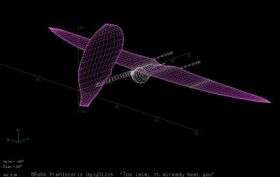Pterodactyl-inspired robot to master air, ground and sea

Paleontologist Sankar Chatterjee of Texas Tech University, aeronautical engineer Rick Lind of the University of Florida, and their students Andy Gedeon and Brian Roberts have reached back in time 115 million years to one of the most successful flying creatures in Earth's history, the pterodactyl, to conjure a robotic spy plane with next-generation capabilities.
Mimicking the physical and biological characteristics of the Early Cretaceous Brazilian pterosaur Tapejara wellnhoferi -- skin, blood vessels, muscles, tendons, nerves, cranial plate, skeletal structure, and more -- the scientists are working to develop a Pterodrone -- an unmanned aerial vehicle that not only flies but also walks and sails just like the original.
"The next generation of airborne drones won't just be small and silent," says the multidisciplinary group, "they'll alter their wing shapes using morphing techniques to squeeze through confined spaces, dive between buildings, zoom under overpasses, land on apartment balconies, or sail along the coastline."
The talk on Tuesday, 7 October at the 2008 Joint Meeting of the Geological Society of America, Soil Science Society of America-American Society of Agronomy-Crop Science Society of America, and Gulf Coast Association of Geological Societies, in Houston, Texas, will provide illustrations of both the Tapejara and the proposed Pterodrone, with details on the richly improved ability of the robotic spy plane to gather data from sights, sounds, and smells in a variety of environments.
Source: Geological Society of America





















